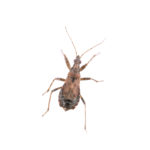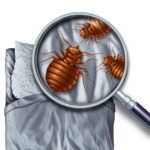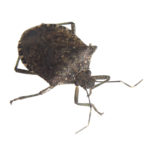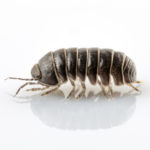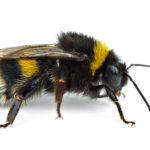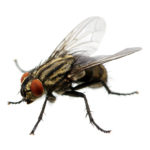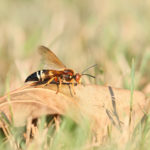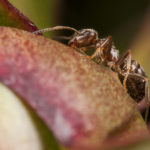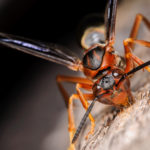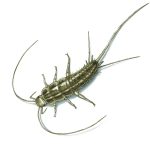There are several species of kissing bugs. Two of the most common are the bloodsucking conenose bug, Triatoma sanguisuga (LeConte), and the western bloodsucking conenose bug, Triatoma protracta (Uhler). These bugs can be 14 to 24 mm long. They are dark colored, usually brown or black. Some species have red, yellow or tan markings on […]
Bed Bugs
COMMON NAME: Bed Bug SCIENTIFIC NAME: Cimex lectularius Linnaeus CLASS/ORDER/FAMILY: Insecta/Heteroptera/Cimicidae INTRODUCTION. This bug probably received its common name of bed bug from its close association with human sleeping beds where it often seeks refuge during daylight, only to come out to feed on the bed’s occupant(s) at night. The bed bug is an ecto-parasite […]
Stink Bugs
STINK BUGS (Pentatomidae) of about 5,000 species characteristically give off a strong odor when disturbed. Sometimes the odor can be smelled, or tasted, on fruits or vegetables on which the bugs have been crawling or feeding. Members of this family, which is worldwide in distribution, are easily recognized by their shield-like shape and by the […]
Pillbugs
INTRODUCTION: Pillbugs are sometimes called “roly-polies” and get this common name because they roll up into a tight ball when disturbed. These land-dwelling crustaceara are arthropods but not insects. RECOGNITION: Adults about 1/4-5/8″ (7-15 mm) long, convex above but flat or hollow beneath. Color slate gray. BIOLOGY: The eggs are deposited and hatch within the […]
Bumble Bees
INTRODUCTION: The common name of bumble bee possibly comes from their rather large, clumsy appearance and/or the buzzing sound they make as they fly. In the urban setting, bumble bees do not usually nest in structures but are of concern because of their abundance around the many flowering plants typical of yards, and because they […]
House Fly
INTRODUCTION: These flies receive the common name of house from being the most common fly found in and around homes, especially in the pre-automobile era and in rural areas. It is not only a nuisance pest but of greater concern is its potential as a carrier of disease organisms, having been found to harbor over […]
Cicada Killers
INTRODUCTION: This wasp gets its common name from the fact that it hunts and provisions each of its nest cells with a cicada (Homoptera: Cicadidae) as food for its young. These wasps can become an urban nuisance pest when they select a bare area around a structure as a nesting site. People become alarmed because […]
Pharaoh Ants
Its name resulted from the mistaken belief of Linnaeus that this ant was one of the plagues of Egypt in the time of the Pharaohs. Pharaoh ants are thought to be native to the African region. This ant is found throughout the United States. Pharaoh ants have been strongly implicated in the spread of various […]
Paper Wasps
Paper wasps get their common name from the paper like material of which they construct their nests; true also of the other vespids. It has been suggested that they be called umbrella wasps based on the shape of their nests. In the urban situation, these usually unaggressive wasps are a nuisance pest Adults are about […]
Silverfish/Bristletails
INTRODUCTION: All members of the order Thysanura have a teardrop/carrot/fish-shaped body and get their common name of bristletail because of their 3 long, bristle like or tail like appendages on the posterior/rear end of their body. Silverfish is a common name for species of this group whose bodies are covered with silvery scales. Silverfish are found throughout the […]

